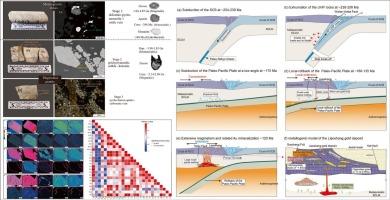Geochronological and petrochemical constraints on Paleoproterozoic granites in the Liaoshang gold deposit, Jiaodong Peninsula: Implications for geological setting and ore sources
IF 3.6
2区 地球科学
Q1 GEOLOGY
引用次数: 0
Abstract
The Liaoshang gold deposit in the Jiaodong Peninsula is a tectonically controlled pyrite-carbonate vein-type system, genetically distinct from the Jiaojia-type altered rock-hosted and Linglong-type quartz-vein gold deposits in the region. Due to the considerable resource potential of Jiaodong gold deposits, extensive research has been conducted on their temporal and metal sources, yet the geological framework of individual mining districts such as the Liaoshang deposit remains poorly constrained. This study integrated petrography, geochemistry, and U − Pb geochronology of zircon, apatite and monazite from local granitiods to elucidate the tectonic history and mineralization processes. Two granite types were identified: plagioclase granites emplaced at 2.14–2.09 Ga, which underwent regional metamorphism at 1.98–1.83 Ga, and monzogranite dykes intruding the meta-sedimentary rocks of the Paleoproterozoic Jingshan Group crystallized at 1.85–1.84 Ga. Apatite from the dykes records a metamorphic age of 248 ± 15 Ma, indicating involvement in the Triassic Sulu ultrahigh-pressure orogeny. Hydrothermal monazite from the monzogranite yields a lower intercept U-Pb age of 140 ± 5.7 Ma, predating the main mineralization event at Liaoshang (∼116 Ma) and other Jiaodong deposits (∼120 Ma) by approximately 20 Ma. Petrographic and microstructural evidence further suggest an early hydrothermal event, implying that ore formation was a prolonged, multi-stage process lasting at least ∼ 20 Ma. Whole-rock geochemistry shows that, compared to those of weakly altered granites, mineralized plagioclase granites are significantly enriched in Ag, Pb, As, Te, Sb and Bi. These elements also correlate strongly with Au and total Fe2O3, indicating co-precipitation with polymetallic sulfides and native gold. In addition, As-rich zonation also exists in pyrite formed during the main mining period. Combined with the elevated arsenic content and the obvious Au − As correlation, these findings highlight the important contribution of Precambrian basement rocks, particularly the Jingshan Group metasediments, to the metal endowment of the Liaoshang gold system.

胶东半岛辽上金矿床古元古代花岗岩的年代学和石油化学约束:地质背景和矿床来源意义
胶东半岛辽上金矿床是构造控制的黄铁矿-碳酸盐脉状金矿床,与该区焦家型蚀变岩型和玲珑型石英脉状金矿床在成因上有明显区别。胶东金矿床资源潜力巨大,对其时间和金属来源进行了广泛的研究,但对辽上金矿等个别矿区的地质格局仍知之甚少。本研究综合了当地花岗岩中锆石、磷灰石和独居石的岩石学、地球化学和U - Pb年代学,以阐明构造历史和成矿过程。鉴定出2种花岗岩类型:位在2.14 ~ 2.09 Ga的斜长石花岗岩,在1.98 ~ 1.83 Ga经历了区域变质作用;侵入古元古代景山群变质沉积岩的二长花岗岩岩脉在1.85 ~ 1.84 Ga结晶。岩脉磷灰石的变质年龄为248±15 Ma,参与了三叠纪苏鲁超高压造山运动。来自二长花岗岩的热液独居石的截距U-Pb年龄较低,为140±5.7 Ma,比辽上(~ 116 Ma)和胶东其他矿床(~ 120 Ma)的主要成矿事件早约20 Ma。岩石学和微观结构证据进一步表明了早期的热液事件,这意味着成矿是一个延长的多阶段过程,持续时间至少为~ 20 Ma。全岩地球化学表明,与弱蚀变花岗岩相比,矿化斜长石花岗岩显著富集Ag、Pb、As、Te、Sb和Bi。这些元素还与Au和总Fe2O3密切相关,表明与多金属硫化物和天然金共析出。此外,主采期形成的黄铁矿也存在富砷分带。研究结果表明,前寒武纪基底岩,特别是景山群的沉积对辽上金系统的金属赋存有重要贡献。
本文章由计算机程序翻译,如有差异,请以英文原文为准。
求助全文
约1分钟内获得全文
求助全文
来源期刊

Ore Geology Reviews
地学-地质学
CiteScore
6.50
自引率
27.30%
发文量
546
审稿时长
22.9 weeks
期刊介绍:
Ore Geology Reviews aims to familiarize all earth scientists with recent advances in a number of interconnected disciplines related to the study of, and search for, ore deposits. The reviews range from brief to longer contributions, but the journal preferentially publishes manuscripts that fill the niche between the commonly shorter journal articles and the comprehensive book coverages, and thus has a special appeal to many authors and readers.
 求助内容:
求助内容: 应助结果提醒方式:
应助结果提醒方式:


